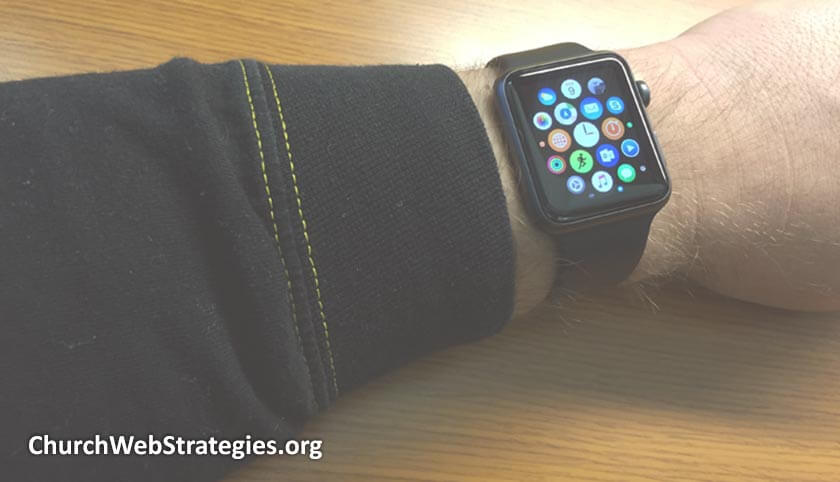Wearable technology, namely watches, are the latest craze. They have become popular for a good reason. They can perform many simple tasks and have a wide range of functions. Essentially, smartwatches have become an extension of your smartphone. Many churches have, or are thinking of creating a mobile application. In this article I will discuss four critical points on how church apps should interact with wearable technology.
So I am getting an Apple Watch for Christmas this year. Of course I could not just let it sit in the box. What if it was broken and I needed to order a replacement? At least that is what I told my wife as an excuse to try it out for a few days. Because of my job as a user experience (UX) professional, I did not just sit back and play. I began looking at interfaces and features. Immediately I started asking myself questions about the design. My mind quickly went to church applications.
Critical Tasks
My financial institution has many tasks I can perform online. The desktop website has the widest range of features. Their mobile app has just a few less. Yet the watch app has just two, view balances and transfer money. Their user experience department determined those were the most important tasks to perform on a watch. I would say they pretty much nailed it.
So what are the most critical information and tasks a user would want to see? Your most probable user demographic is an existing member of your congregation. If you have mobile giving integrated to your app, this would be a great watch task. Another would be checking into your church on social media. Your members can share with their friends and use it for a future invitation to come with them. If you have idea for a user-initiated task from a smartphone, please leave it in the comments below.
Curated Responses
Data entry is cumbersome on tablets. It is somewhat difficult on phones. On watches it is next to impossible. This is predominantly due to the small screen size. Even on my larger 42mm Apple Watch, the interface is prone to tapping on the wrong thing. The smallest data entry is a 10-digit keypad. Yet my watch allows me to respond to text messages. How? Through a list of predefined responses. It has typical responses like “Thanks!”, “Yes”, “No”, and also allows me to use Siri for dictation.
The lesson here is if you need responses or input of any kind, think about the scenarios first. Consider the most common things a user would want to say, or how they might answer a question. Recall my previous scenario of tithing. The most you would want a user to do is input the amount of money they wish to give. Or for one-time-gifts, have some suggested donations. Use the hybrid method I suggested on my article on influencing the outcome of donations.
Notifications
The handiest part of wearable technology is fast access to notifications. No need to dig your phone out of your pocket or purse. Just glance at your wrist. One of the most helpful uses of my watch is in conjunction with a navigation app. Using a GPS device or app is dangerous while driving. You need to take your eyes off the road and see where you are to turn next. Additionally, you need to hear it. So loud music lovers are left to suffer their ride with a more moderate volume of entertainment. Not so with a smartwatch. I get a slight vibration and see the turn notification right on my wrist. So how can notifications help your church application?
If your application integrates with any calendar functions, you are in luck. The ability to remind people of an event is probably the most useful thing you can do for your church. Another use can be a daily devotional. Allow users to select a time for a reminder to read scripture. Yet in the end, the key here is to not overdo it. Constant buzzing and vibrating on your wrist would soon become annoying. If your notifications are no longer helpful and nagging; users will turn them off.
Follow-On Action
I have been using email for nearly twenty years. So I get a lot of emails every day. Around Christmas it is even worse. When I get a new message, I glance at the email sender and subject. Based on what I see, I often delete it without ever opening it.
Deleting an unopened email is not the action you want users to take on your newsletter. But the notion of a quick follow-on action is great. Did you just send them a notification about an event? Include the event’s address and allow them to launch a navigation app. Did you remind them to read their Bible today? Include the verses from their reading plan. Whatever the notification is, include information for people to take action.
Action Item
Consider how you want your church application to interact with a wearable device. First think of the most important and practical tasks you want to do via that small interface. Second, prepare the typical responses you expect people to use. Be thoughtful and do not nudge too hard for responses you prefer. Next, see where it makes sense to send notifications. Help your users stay faithful to things they opt into. It could be attending church services, reading their Bible, or a reminder to tithe. Lastly, consider what sort of follow-on actions you can attach to those notifications. Remove as many barriers as possible so your congregation can engage with your digital ministries. Now go get planning for your next mobile app update!

